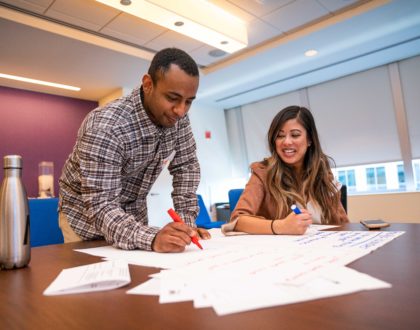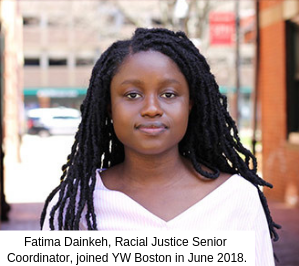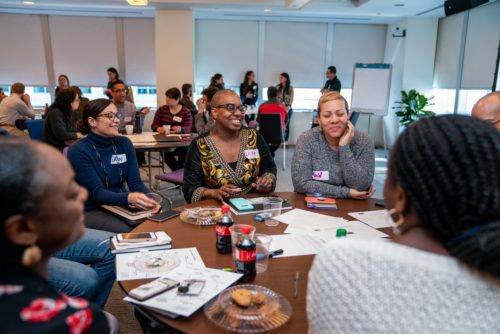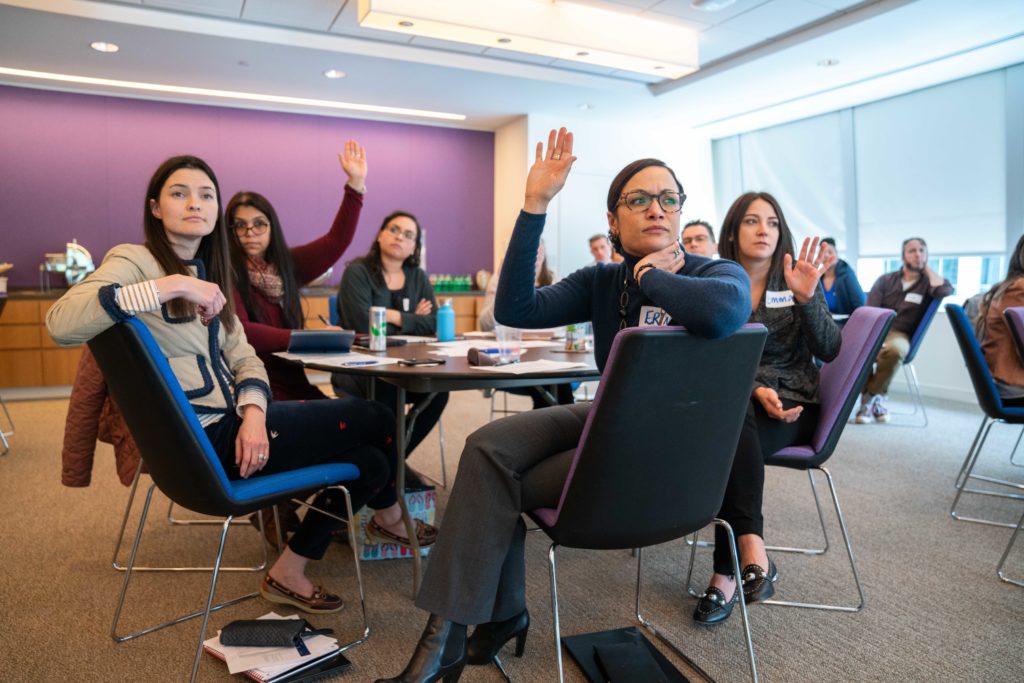Beyond the DE&I Acronym: What are Diversity, Equity, and Inclusion?

Diversity, Equity, and Inclusion, or DE&I as it is commonly referred, is a phrase that broadly outlines the efforts an institution takes to create a more welcoming environment for people of less-privileged identities. This can mean working to ensure your upper management is not fully comprised of white men or implementing mentorship opportunities for young professionals of color in your workplace. As a whole, Diversity, Equity, and Inclusion efforts seek to create meaningful, systemic change toward more equitable environments.
Diversity, Equity, and Inclusion can include any number of interventions, and therefore can feel daunting. Additionally, Diversity, Equity, and Inclusion is referred to as DE&I so often that many individuals don’t know what each letter refers to. Part of the barrier to getting started building a DE&I strategy is not knowing the difference between these three concepts, and therefore how to address each. To help get you started, we’ve broken down the individual parts: Diversity, Equity, and Inclusion.
In this blog post, you’ll learn about them as individual concepts and how they fit together. To provide experiential context, Fatima Dainkeh, YW Boston’s Senior Coordinator of Dialogues, helps explain how YW Boston’s Dialogues on Race and Ethnicity program approaches Diversity, Equity, and Inclusion.
Learn more below:
What is diversity? What is equity? What is inclusion?
Boiled down simply, Independent Sector does a great job of explaining the definitions of each of these terms:
Diversity “includes all the ways in which people differ, encompassing the different characteristics that make one individual or group different from another,” including identity markers such as race, ethnicity, gender, disability, sexual orientation, religion, and more. It also takes intersectional diversity into account, when people’s identity is made of a number of underrepresented identities. As Fatima puts it, diversity is often boiled down to a people’s perception when they walk into a room and say, “people look different.”
Equity is “the fair treatment, access, opportunity, and advancement for all people, while at the same time striving to identify and eliminate barriers that have prevented the full participation of some groups. Improving equity involves increasing justice and fairness within the procedures and processes of institutions or systems, as well as in their distribution of resources.” Fatima emphasized that equity is centered on fair treatment, such as any group of individuals’ “access, opportunities for advancement, and feeling like they are growing in the organization.”
Inclusion is “the act of creating environments in which any individual or group can be and feel welcomed, respected, supported, and valued to fully participate. An inclusive and welcoming climate embraces differences and offers respect in words and actions for all people.” Inclusion goes beyond diversity, because once you have a diverse staff, organizations must focus on retention.
YW Boston often uses inclusion strategist Vernã Myers’ analogy: “Diversity is being invited to the party; inclusion is being asked to dance.” In addition, diversity is often thought of as being quantifiable by measuring who is represented in an institution. Inclusion is measured through qualifiable data, looking at attitudes and people’s perceptions of how welcoming an organization.
Why is it unhelpful to boil it all down to simply DE&I?
Now that we know the differences in Diversity, Equity, and Inclusion, we can see why it is harmful to equate the three with one another. Goal setting is an important aspect of DE&I work, but diversity, equity, and inclusion each require different methods of intervention, different resources, and different tools for measurement.
When Diversity, Equity, and Inclusion are boiled down to DE&I, diversity often becomes the focus. Because racial, ethnic, and/or gender diversity can sometimes (but not always) be determined by visually scanning an organization, organizations may feel it is the easiest to measure and the easiest to tackle. As Fatima states, “Some organizations are really at that step of diversity,” however “diversity is not going to meet equity or inclusion.” Diversifying the workforce is important, but that doesn’t directly lead to those new hires feeling welcomed or supported in the organization. Fatima further explains, “often times organizations are checking the box and saying we have a diverse racial/ethnic group, but they do not understand why their diverse staff is unhappy or unable to complete their tasks. This may be because their staff isn’t being supported or the expertise they are coming in with isn’t understood at an organizational level.” An organization like this may have staff diversity, but it likely needs to work on its equity and inclusion practices.
To be able to move beyond diversity, Fatima explains, an organization must work with “an understanding that the systems we are working in, especially when we think about institutions, are not equal, they are not equitable. So you are recognizing that you have to move beyond just having people in the room or at the table.” She often meets with organizations that assume “that diversity equals inclusivity,” and has found that while “that’s not necessarily the case…a lot of times inclusivity, if you are truly inclusive, diversity usually comes along with that.”
In addition, many people assume that DE&I work refers specifically to race and gender, but really it can address any or all systemic issues of inequity. By looking deeper than the DE&I acronym, an organization can determine whether there is a particular systemic inequity it must address.
How can an organization address each concept?
Increasing diversity within an organization most often means working with the Human Resources team, and any others in charge of hiring and promotion. It may mean creating or adjusting your hiring handbook, or including language in job postings that indicate that people of color, women and non-binary individuals, those with disabilities, etc. are encouraged to apply. It also addresses, “who are you reaching out to make your organization look racially diverse,” says Fatima.
Inclusion works to create a welcoming work culture – one where individuals of all identities and racial and ethnic backgrounds feel that they are being supported and able to succeed. One strategy many workplaces employ is creating an Inclusion Committee. Committees such as these work with senior leadership and provide a space for individuals to brainstorm how to better support people of color and women in all levels.
By focusing on equity, an organization addresses all aspects of their work with an understanding that not all employees or potential employees have access to the same resources. This means that you can approach both of the above diversity and inclusion examples with an equity lens.

So, when it comes to diversity, using an equity lens means asking questions such as those Fatima poses: “Where are you posting the job description? Is the language accessible? Are you listing skills that allow other people to apply?” For example, you may recognize that while the job states “Masters degree preferred”, not all prospective employees have had access to graduate education, so it is worth evaluating comparable skills sets for the job, such as experience working in the community.
Addressing equity in your inclusion work could mean providing ample support to the above-proposed Inclusion Committee. Utilizing an equity lens means realizing that people of less privileged backgrounds often do not enter an organization with the same resources as their privileged counterparts. Therefore, it is equitable to provide additional support to those on the committee, such as helping them build it into the work plans or providing them with professional development opportunities. Additionally, an equitable lens recognizes that if people of color and women could have ended racism and sexism years ago, they would have. Therefore, leadership must ensure that white people and men are on the committee and are committed to change on an institutional level.
Where does Dialogues on Race and Ethnicity come in?
The above scenarios are just examples. It requires time and energy to determine the best strategy for your organization. This is where YW Boston’s Dialogues on Race and Ethnicity program comes in. The Dialogues program helps organizations create the necessary cultural shift that will support inclusive policies and practices. Over the course of five sessions led by expert facilitators, participants develop a better understanding of their own identities and how individual behaviors can influence organizational culture. Using our advanced assessment tool and the latest research on behavioral and organizational change, Dialogues partners with organizations to create an action plan and provide them with the resources needed to drive organizational change.
 The sessions themselves are Fatima’s favorite part of the program. The first three sessions are focused primarily on trust building, with participants discussing race and ethnicity together. As Fatima puts it, “there’s often no space in the organization for people to have a talk table to say ‘When I grew up..’ or ‘Let me explain to you where I am coming from…’ or ‘Let me explain what race means to me and my experience with racism and how I have been advantaged or disadvantaged or been privileged or not privileged’ and so that piece is beautiful to see. You see people connecting on a level that they didn’t think they’d be able to connect at. The beauty of seeing both the hard, yet the humble and seeing how people interact and engage with one another makes you realize that the work does start individually. I think a lot of times we think about systems and forget that people run systems. If you haven’t done the internal work, I don’t know how you’re going to change the system.” Team trust is a crucial part of advancing racial equity in any organization.
The sessions themselves are Fatima’s favorite part of the program. The first three sessions are focused primarily on trust building, with participants discussing race and ethnicity together. As Fatima puts it, “there’s often no space in the organization for people to have a talk table to say ‘When I grew up..’ or ‘Let me explain to you where I am coming from…’ or ‘Let me explain what race means to me and my experience with racism and how I have been advantaged or disadvantaged or been privileged or not privileged’ and so that piece is beautiful to see. You see people connecting on a level that they didn’t think they’d be able to connect at. The beauty of seeing both the hard, yet the humble and seeing how people interact and engage with one another makes you realize that the work does start individually. I think a lot of times we think about systems and forget that people run systems. If you haven’t done the internal work, I don’t know how you’re going to change the system.” Team trust is a crucial part of advancing racial equity in any organization.
These first three sessions set the groundwork for participants to identify diversity, equity, and inclusion gaps in their organization and create a plan to address them. The facilitators help them flesh out their plan, and after the five sessions are over, YW Boston staff members follow up with the organization at one, three, six, nine, and twelve months to see how their plan is going. Fatima likes to think of it this way: “We are like their accountability partners, so we are not doing the work, but we are supporting them in doing the work” to make sure they see their plan through.
What do I do now?
Even after understanding the differences in Diversity, Equity, and Inclusion, actually putting a plan in place can feel daunting.
Fatima has three main pieces of advice for all organizations to remember on their DE&I journey:
- “It takes time. It took hundreds of years to create these inequalities in our institutions, and it may take as much time to dismantle these structures. So it is a marathon, not a sprint.”
- “Another thing is people need to recognize that there is not one right way or one way to do racial equity work or engage in racial equity work. There are a lot of things that play into organizational culture, not just organizational structure but also the dynamics, personality. Reminding folks there is no one way, no right way, but there is a way that works for you. As long as it has a racial equity lens, that is the most important thing.”
- “It is not easy work. It is ok to recognize that and to know that often when people ask to do this work, they are working under the assumption that it is going to fit perfectly into their workplace and organization. The truth is you have to be very intentional about creating the space. People have to realize that this isn’t extra work. This is work. Research shows that having leadership buy-in and trail-leaders, having this combination at your organization, is the magic ingredient list to make a beautiful recipe. It takes time. Holding the space, creating the space within the organizations takes time, takes willingness, takes energy. You have to believe that it is part of your work and not separate.”

Consider reaching out to experts to ensure your organization makes
the space and time to create a DE&I plan.
Learn more about YW Boston’s Dialogues on Race and Ethnicity here.
To learn more or to bring Dialogues to your workplace, email Sheera Bornstein, Senior Manager of Partnerships, at sheera@ywboston.org.
